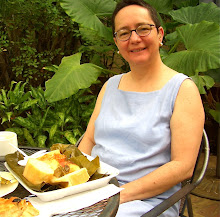
Above, Archangel San Rafael, polychromatic wood carving

 During the Colonial period in Nicaragua, from the early 16th century to the early 19th century, many cathedrals, chapels, shrines and sanctuaries were built, especially in Granada, and supplied with religious statuary from Spain. Although Nicaragua did not have established schools dedicated to the training of religious sculptors, there were many friars, carpenters, carvers and joiners who became specialists with great expertise. In general the products of these artisans were a mixture of indigenous and mestizo styles, mimicking Spanish treatment of carved fabric folds and draping in wood, but painted with bright, festive colors of the indigenous palate. Often anatomical proportions were not observed, resulting in figures with shorter bodies and larger heads.
During the Colonial period in Nicaragua, from the early 16th century to the early 19th century, many cathedrals, chapels, shrines and sanctuaries were built, especially in Granada, and supplied with religious statuary from Spain. Although Nicaragua did not have established schools dedicated to the training of religious sculptors, there were many friars, carpenters, carvers and joiners who became specialists with great expertise. In general the products of these artisans were a mixture of indigenous and mestizo styles, mimicking Spanish treatment of carved fabric folds and draping in wood, but painted with bright, festive colors of the indigenous palate. Often anatomical proportions were not observed, resulting in figures with shorter bodies and larger heads.Above left, San Antonio de Padua, polychromatic wood sculpture. San Antonio de Padua is often portrayed with the baby Jesus in his arms. He was born of a noble family in Portugal, but despite his privileged background, joined a monastery. He is commonly known as the patron of all lost items.
Above right, San Pedro, polychromatic wood sculpture. My on-line research indicates that San Pedro was a poor shepherd of Guatemalan origin born in 1619. He attempted to enter the Jesuit priesthood, but with little formal education, was not successful at the Jesuit college in Guatemala City. He then took private vows, and became a Francisan tertiary. He later opened a hospital for the poor, shelters for the homeless, schools for poor children. Pedro built and shrines in the poor sections of the city, and is sometimes credited with originating the Christmas Eve posadas procession in which people representing Mary and Joseph seek a night's lodging from their neighbors. He is the first canonized Guatemalan native.
The wooden statues in today's post are in the museum of the Old San Francisco Convent Cultural Center in Granada.

No comments:
Post a Comment